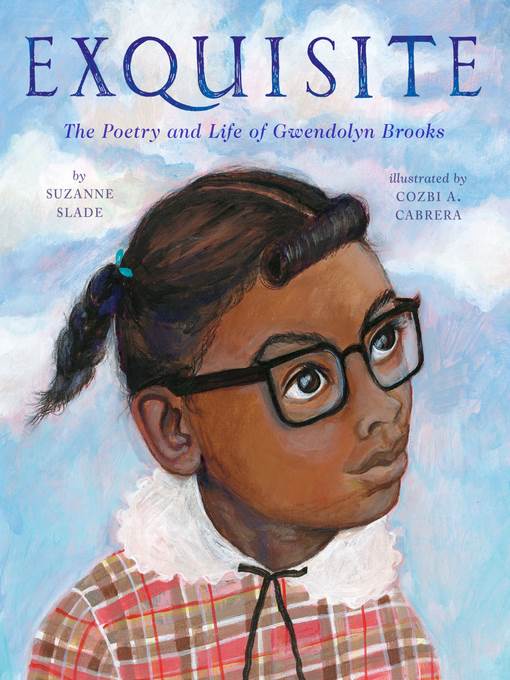
Exquisite
The Poetry and Life of Gwendolyn Brooks
فرمت کتاب
ebook
تاریخ انتشار
2020
Reading Level
3
ATOS
4.8
Interest Level
K-3(LG)
نویسنده
Cozbi A. Cabreraناشر
ABRAMSشابک
9781683354727
کتاب های مرتبط
- اطلاعات
- نقد و بررسی
- دیدگاه کاربران
نقد و بررسی

Starred review from February 1, 2020
K-Gr 3-Gwendolyn Brooks (1917-2000) was inspired to write poetry from an early age. When she wasn't dreaming on her back porch, she was filling notebooks with observations about nature and everyday life in her Chicago neighborhood. Themes of racial injustice, hunger, and poverty stood alongside depictions of joy and wonder in her work. Brooks dedicated her life to writing; she won contests, got published, and eventually became the first black woman to win the Pulitzer Prize in 1950. The biography's awestruck, reverent tone is matched by the gorgeous acrylic paintings. Bright palettes of pink, orange, blue, and green evoke the influence of nature in Brooks's work. There is a lovely contrast between the illustrations of lush outdoor sunsets and the beautifully rendered moments that depict her home life. The only thing missing from the text is more excerpts from Brooks's poetry. Shining a spotlight on the poet's own words would have enriched the context of her life story and shown how life can influence art and vice versa. Extensive back matter includes a poem by 15-year-old Brooks titled "Clouds," an author's note, a time line, source notes, and a bibliography. VERDICT A visually remarkable and inspiring introduction to the life of Gwendolyn Brooks. Recommended for purchase in most collections.-Kristy Pasquariello, Westwood Public Library, MA
Copyright 2020 School Library Journal, LLC Used with permission.

February 15, 2020
Poet Gwendolyn Brooks' life is chronicled for young readers. Growing up with a love for poetry that's fed by her father's recitations and her mother's affirmations ("You are going to be the lady Paul Laurence Dunbar"), young Gwendolyn begins writing as early as 7. Poetry is everything to Gwendolyn, feeding her emotionally during the Great Depression and beyond. She writes by candlelight when the electricity is out and submits poems to publishers all over the country. Eventually they are published, but they don't earn much--and then one day a phone call delivers joyous news: She is the first black writer to win the Pulitzer Prize! Slade's uneven rhythms emulate Brooks' but at times detract from a sense of textual cohesion; a superfluous explanation of the usage of "Black" in the author's note feels awkward, as if seeking validation. On the other hand, Cabrera's acrylic paint illustrations perfectly exemplify the title. Attention to detail, like the pink sponge roller in little Gwendolyn's hair for a delightfully bumped bang and the dreamy bright pinks and blues of early spreads, with clocks and printed pages lining Gwendolyn's imagination, adds a tangible depth to this story of her triumphs and challenges. Additional backmatter, including Brooks' poem "Clouds," a timeline, sources, and select bibliography, provides context and grounding for the airy book. A joyfully illustrated celebration of Brooks' good and important work. (Picture book/biography. 7-11)
COPYRIGHT(2020) Kirkus Reviews, ALL RIGHTS RESERVED.

April 6, 2020
In stirring free verse and resplendent acrylic paintings, these collaborators pay affecting tribute to Brooks, who, in 1950, became the first black person to receive a Pulitzer Prize. Laced with Brooks’s spoken and written words, the lyrical narrative by Slade echoes the personal tenor of the subject’s poetry, inspired by “the nonstop busyness, the hard-luck grittiness” of her neighborhood in Chicago’s South Side. One of Brooks’s poems, “Clouds,” printed at the book’s end, provides a leitmotif executed in tandem by Slade and Cabrera; in one spread that includes a quote from the poet, a young Brooks gazes at a cotton candy–hued sunset sky, dreaming about the future. Despite publishers’ rejection letters and financial struggles during the Depression, she continued to believe in that hopeful future as “everywhere she looked, Gwendolyn saw more stories that needed to be told. So she kept writing.” This fine biography should ignite readers’ interest in exploring Brooks’s exquisite writing. Ages 6–9.

























دیدگاه کاربران